
/****************************************************************
Function: IAP_Init
Description: IAP initialization function, initialize serial port 1
Input: none
return: none
**********************************************************/
void IAP_Init(void)
{
GPIO_InitTypeDef GPIO_InitStructure;
USART_InitTypeDef USART_InitStructure;
NVIC_InitTypeDef NVIC_InitStructure;
RCC_APB2PeriphClockCmd(COM1_RCC, ENABLE);//Enable USART1 clock
RCC_APB2PeriphClockCmd(COM1_GPIO_RCC, ENABLE);//Enable serial port 2 pin clock
GPIO_InitStructure.GPIO_Mode = GPIO_Mode_AF_PP;//Configure USART1 Tx The pin type is push-pull
GPIO_InitStructure.GPIO_Pin = COM1_TX_PIN;
GPIO_InitStructure.GPIO_Speed = GPIO_Speed_50MHz;
GPIO_Init(COM1_GPIO_PORT, &GPIO_InitStructure);
GPIO_InitStructure.GPIO_Mode = GPIO_Mode_IN_FLOATING; //Configure USART1's Rx as input floating
GPIO_InitStructure.GPIO_Pin = COM1_RX_PIN;
GPIO_Init(COM1_GPIO_PORT, &GPIO_InitStructure);
USART_InitStructure.USART_BaudRate = 115200; //Set the baud rate to 115200
USART_InitStructure.USART_WordLength = USART_WordLength_8b;//Set data bits to 8 bitsUSART_InitStructure.USART_StopBits
= USART_StopBits_1;//Set stop bit to 1 bitUSART_InitStructure.USART_Parity
= USART_Parity_No;//No parity checkUSART_InitStructure.USART_HardwareFlowControl
= USART_HardwareFlowControl_None;//No hardware flow controlUSART_InitStructure.USART_Mode
= USART_Mode_Rx | USART_Mode_Tx;//Send and receiveUSART_ITConfig
(COM1, USART_IT_RXNE, ENABLE);//Receive interrupt enableUSART_Init
(COM1,&USART_InitStructure);//Configure serial port 2 related registersUSART_Cmd
(COM1,ENABLE); //Enable serial port 2
NVIC_InitStructure.NVIC_IRQChannel = USART1_IRQn; //Channel is set to serial port 2 interrupt
NVIC_InitStructure.NVIC_IRQChannelSubPriority = 0; //Interrupt occupies priority 0
NVIC_InitStructure.NVIC_IRQChannelCmd = ENABLE; //Enable interrupt
NVIC_Init(&NVIC_InitStructure);
}
/****************************************************************
Function: IAP_SerialSendByte
Description: Serial port sends byte
Input: c-byte to be sent
Return: none
**************************************************************/
static void IAP_SerialSendByte(u8 c)
{
USART_SendData(COM1, c);
while (USART_GetFlagStatus(COM1, USART_FLAG_TXE) == RESET) {}
}
/*****************************************************************
Function: IAP_SerialSendStr
Description: Serial port sends string
Input: none
Return: none
*************************************************************/
void IAP_SerialSendStr(u8 *s)
{
while(*s != '\0')
{
IAP_SerialSendByte(*s);
s++;
}
}
#define MAXBUFFER 512 //buffer size
u8 UsartBuffer[MAXBUFFER]; //data buffer
u16 UsartWptr = 0;
u16 UsartRptr = 0;
/****************************************************************
Function: IAP_BufferWrite
Description: Write buffer
Input: none
return: none
**********************************************************/
void IAP_BufferWrite(void)
{
if(UsartWptr == (UsartRptr - 1))//The buffer is full
{
return;//Return
}
UsartBuffer[UsartWptr] = USART_ReceiveData(COM1);//Access serial port data
UsartWptr++;//Buffer write position value increments
UsartWptr = UsartWptr%MAXBUFFER;//Ensure that the write position value does not overflow
}
/*****************************************************************
Function: IAP_BufferRead
Description: Read buffer
Input: none
return: none
*****************************************************************/
static u8 IAP_BufferRead(u8 *data)
{
if(UsartRptr == UsartWptr)//No data to read
{
return 0;
}
*data = UsartBuffer[UsartRptr];//Read buffer data
UsartRptr++;//Read position value increments
UsartRptr = UsartRptr % MAXBUFFER;//Ensure that the read position value does not overflow
return 1;
}
/****************************************************** ************
Function: IAP_ShowMenu
Description: Display menu interface
Input: none
return: none
************************ *************************************/
void IAP_ShowMenu(void)
{
IAP_SerialSendStr("\r\ n+================(C) COPYRIGHT 2014 Ziye334 ================+");
IAP_SerialSendStr("\r\n | In-Application Programing Application (Version 1.0) |");
IAP_SerialSendStr("\r\n+----command----+-----------------function- ------------------+");
IAP_SerialSendStr("\r\n| 1: FWUPDATA | Update the firmware to flash |");
IAP_SerialSendStr("\r\n| 2: FWERASE | Erase the current firmware |");
IAP_SerialSendStr("\r\n| 3: BOOT | Excute the current firmware |");
IAP_SerialSendStr("\r\n| 4: REBOOT | Reboot |");
IAP_SerialSendStr(" \r\n| ?: HELP | Display this help |");
IAP_SerialSendStr("\r\n+============================ ================================+");
IAP_SerialSendStr("\r\n\r\n");
IAP_SerialSendStr("STM32-IAP>>");
}
extern u8 rcvTimeout; //Receive timeout flag
/****************************************************************
Function: IAP_UpdataProgram
Description: Update program
Input: none
Return: none
**********************************************************/
static void IAP_UpdataProgram(void)
{
u8 blockNum = 0; //Block, 4 pages per block, for STM32F10X_HD, 1 page is 2Kbytes
u8 n = 0;
u8 data = 0;
u8 datalow = 0;
u8 datahigh = 0;
u32 UserMemoryMask = 0;
rcvTimeout = 0; //Clear receive timeout flag
blockNum = (IAP_ADDR - FLASH_BASE_ADDR) >> 12; //Calculate flash block
UserMemoryMask = ((u32)(~((1 << blockNum) - 1))); //Calculate the mask
//Check whether the area where the block is located is write protected
if((FLASH_GetWriteProtectionOptionByte() & UserMemoryMask) != UserMemoryMask)
{
FLASH_EraseOptionBytes (); //Turn off write protection
}
while(1)
{
switch(n)
{
case 0:
if(IAP_BufferRead(&data)) //Receive ground byte data
{
datalow = data;
n = 1;
}
else
{
break;
}
case 1:
if(IAP_BufferRead(&data)) //Receive high byte data
{
datahigh = data;
n = 0;
IAP_FlashProgramdata(((u16)(datalow)) | ((u16)(datahigh << 8)));
}
if(rcvTimeout) //Receive timeout, error or end of receive
{
datahigh = 0xff;
n = 0;
IAP_FlashProgramdata(((u16)(datalow)) | ((u16)(datahigh << 8)));
}
default:
break;
}
if(rcvTimeout)//Receive timeout
{
break;
}
}
}
/****************************************************************
Function: IAP_FlashProgramdata
Description: Burn data
Input: data-data to be burned
Return: none
*************************************************************/
static void IAP_FlashProgramdata(u16 data)
{
static u32 flashwptr = IAP_ADDR;
FLASH_Unlock();//flash lock
FLASH_ClearFlag(FLASH_FLAG_EOP | FLASH_FLAG_PGERR | FLASH_FLAG_WRPRTERR);//clear flash related flags
FLASH_ProgramHalfWord(flashwptr, data); //burn half word data
if(flashwptr == IAP_ADDR)//start burning
{
IAP_SerialSendStr("\r\nUpdating firmware to 0x8005000 ");
}
IAP_SerialSendStr("."); //Show the burning process
flashwptr = flashwptr + 2; //Move the burning address
FLASH_Lock(); //Flash unlock
}
/****************************************************************
Function: IAP_FlashEease
Description: Erase Flash
Input: none
return: none
**********************************************************/
static void IAP_FlashEease(void)
{
u16 eraseCounter = 0;
u16 nbrOfPage = 0;
nbrOfPage = (FLASH_BASE_ADDR + FLASH_SIZE - IAP_ADDR)/PAGE_SIZE;//Calculate the number of pages
FLASH_Unlock(); //Release flash erase and write lock
FLASH_ClearFlag(FLASH_FLAG_EOP | FLASH_FLAG_PGERR | FLASH_FLAG_WRPRTERR);//Clear flash related flags
for(eraseCounter = 0; eraseCounter < nbrOfPage; eraseCounter++)//Start erasing
{
IAP_SerialSendStr(".");//Display progress
FLASH_ErasePage(IAP_ADDR + (eraseCounter * PAGE_SIZE));//Erase
}
FLASH_Lock();//Flash erase and write lock
}
typedef void (*pFunction)(void);
pFunction Jump_To_Application;
u32 JumpAddress; //jump address
/****************************************************************
Function: IAP_JumpToApplication
Description: Jump to the upgrade program
Input: none
return: none
**********************************************************/
void IAP_JumpToApplication(void)
{
if(((*(__IO u32 *)IAP_ADDR) & 0x2FFE0000) == 0x20000000)//There is an upgrade code, the IAP_ADDR address processing should point to the main stack area, that is, 0x20000000
{
JumpAddress = *(__IO u32 *)(IAP_ADDR + 4);//Get the reset address
Jump_To_Application = (pFunction)JumpAddress;//The function pointer points to the reset address
__set_MSP(*(__IO u32*)IAP_ADDR);//Set the main stack pointer MSP to point to the upgrade mechanism IAP_ADDR
Jump_To_Application(); // Jump to the upgrade code
}
}
/****************************************************** ************
Function: ShwHelpInfo
Description: Display help information
Input: none
return: none
************************ *************************************/
static void ShwHelpInfo(void)
{
IAP_SerialSendStr("\r \nEnter '1' to update you apllication code!");
IAP_SerialSendStr("\r\nRnter '2' to erase the current application code!");
IAP_SerialSendStr("\r\nEnter '3' to go to excute the current application code!");
IAP_SerialSendStr("\r\nEnter '4' to restart the system!");
IAP_SerialSendStr("\r\nEnter '?' to show the help infomation!\r\n");
}
/****************************************************************
Function: IAP_GetKey
Description: Get the input value
Input: none
return: Return the key value
******************************************************************/
static u8 IAP_GetKey(void)
{
u8 data;
while(!IAP_BufferRead(&data)){}//Get the key value from the buffer
return data;
}
/****************************************************************
Function: IAP_WiatForChoose
Description: Function selection
Input: none
return: none
*************************************************************/
void IAP_WiatForChoose(void)
{
u8 c = 0;
while (1)
{
c = IAP_GetKey();//Get key value
IAP_SerialSendByte(c);//Serial port returns key value
switch(c)
{
case '1': //FWUPDATA firmware upgrade
if((IAP_GetKey() == '\r'))//Detect enter key
{
IAP_SerialSendStr("\r\nErasing...");
IAP_FlashEease();//Erase Flash
IAP_SerialSendStr("\r\nErase done!\r\n");
IAP_SerialSendStr("Please send firmware file!\r\n");
IAP_UpdataProgram();//Burn the upgrade code
IAP_SerialSendStr("\r\nFirmware update done!\r\n");
IAP_SerialSendStr("Booting...\r\n");
Delay_ms(500);
NVIC_SystemReset();//Restart
}
break;
case '2'://FWERASE firmware erase
if((IAP_GetKey() == '\r'))//Detect the enter key
{
IAP_SerialSendStr("\r\nErasing...");
IAP_FlashEease();//Erase Flash
IAP_SerialSendStr("\r\nErase done!\r\n");
return;//Exit the loop
}
break;
case '3'://BOOT execute the upgrade program
if((IAP_GetKey() == '\r'))
{
IAP_SerialSendStr("\r\nBotting...\r\n");
if(((*(__IO u32 *)IAP_ADDR) & 0x2FFE0000) != 0x20000000)
{
IAP_SerialSendStr("No user program! Please download a firmware!\r\n");
}
Delay_ms(500);
NVIC_SystemReset();
return;//Exit the loop
}
break;
case '4'://REBOOT system restart
if((IAP_GetKey() == '\r'))//Detect the enter key
{
IAP_SerialSendStr("\r\nRebooting...\r\n");
return;//Exit the loop
}
break;
case '?'://HELP help
if((IAP_GetKey() == '\r'))
{
ShwHelpInfo();//Display help information
return;//Exit the loop
}
break;
default:
IAP_SerialSendStr("\r\nInvalid Number! The number should be either 1, 2, 3, 4or5\r\n");
return;//Exit the loop
}
}
}
#ifndef __IAP_H__
#define __IAP_H__
#include "stm32f10x.h"
#define FLASH_BASE_ADDR 0x8000000 //Flash base address
#define IAP_ADDR 0x8005000 //Upgrade code address
#if defined (STM32F10X_MD) || defined (STM32F10X_MD_VL)
#define PAGE_ SIZE (0x400) / / 1 Kbyte
#define FLASH_SIZE (0x20000) // 128 KBytes
#elif defined STM32F10X_CL
#define PAGE_SIZE (0x800) // 2 Kbytes
#define FLASH_SIZE (0x40000) // 256 KBytes
#elif defined STM32F10X_HD || defined (STM32F10X_HD_VL)
#define PAGE_SIZE (0x800) // 2 Kbytes
#define FLASH_SIZE (0x80000) // 512 KBytes
#elif defined STM32F10X_XL
#define PAGE_SIZE (0x800) // 2 Kbytes
#define FLASH_SIZE (0x100000) // 1 M Byte
#else
# error "Please select first the STM32 device to be used (in stm32f10x.h)"
#endif
void IAP_Init(void);
void IAP_SerialSendStr(u8 *s);
void IAP_ShowMenu(void);
void IAP_WiatForChoose(void);
void IAP_BufferWrite(void );
void IAP_JumpToApplication(void);
#endif
/****************************************************************
Function: TIM2_IRQHandler
Description: Timer 2 interrupt service routine
Input: none
return: none
*************************************************************/
void TIM2_IRQHandler(void)
{
if(TIM_GetITStatus(TIM2, TIM_IT_Update) != RESET)
{
SoftTimer_TimerExecute();
TIM_ClearITPendingBit(TIM2, TIM_IT_Update);
}
}
/****************************************************************
Function: USART1_IRQHandler
Description: Serial port 1 interrupt service routine
Input: none
return: none
**********************************************************/
void USART1_IRQHandler(void)
{
if(USART_GetITStatus(USART1, USART_IT_RXNE) != RESET)//Detect receive interrupt flag
{
SoftTimer_TimerStart(0, 100, RcvTimeoutSet, (void*)0, TIMER_ONESHOT);//Start soft timer 1
IAP_BufferWrite();//Store received data
USART_ClearITPendingBit(USART1, USART_IT_RXNE); //Clear flag
}
}
u8 rcvTimeout = 0; //Receive timeout flag
/****************************************************************
Function: RcvTimeoutSet
Description: Serial port receiving data timeout
Input: parameter-parameter
return: none
*************************************************************/
void RcvTimeoutSet(void *parameter)
{
rcvTimeout = 1; //Set the receive timeout flag
}
/****************************************************** ************
Function: KeyInit
Description: Initialization key
Input: none
return: none
************************* ************************************/
void KeyInit (void)
{
GPIO_InitTypeDef GPIO_InitStructure;
RCC_APB2PeriphClockCmd(RCC_APB2Periph_GPIOA, ENABLE);
GPIO_InitStructure.GPIO_Pin = GPIO_Pin_8;
GPIO_InitStructure.GPIO_Mode = GPIO_Mode_IN_FLOATING;
GPIO_Init(GPIOA, &GPIO_InitStructure);
}
/************************** *************************************
Function: GetKey
Description: Get the key status
Input: none
return: none
* *************************************************** **********/
u8 GetKey (void)
{
return (GPIO_ReadInputDataBit(GPIOA, GPIO_Pin_8));
}
/****************************************************************
Function: main
Description: main entryInput
: none
return: none
**********************************************************/
int main(void)
{
BSP_Init();//Board initializationKeyInit
();//Initialize the keyif
(!GetKey())//Press the key to enter the upgrade interface
{
set: IAP_Init();//Initialize the serial
portSoftTimer_Init();//Initialize the soft timershw
: IAP_ShowMenu();//Show function
menuIAP_WiatForChoose(); //Wait for the selection interfacegoto
shw;//Redisplay the interface
}
else
{
IAP_JumpToApplication();//Jump to the upgrade code executiongoto
set;//This sentence will be executed only if there is no upgrade program or the upgrade program is wrong, and then jump to the upgrade interface
}
}

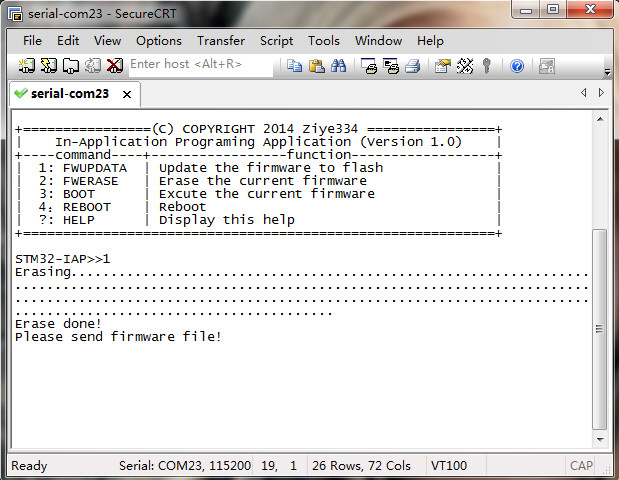

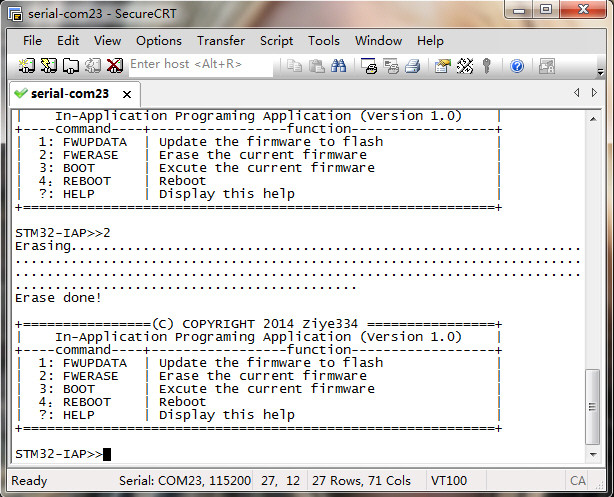
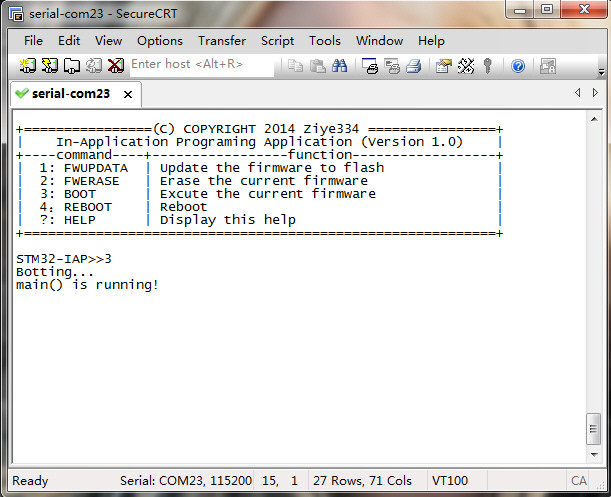
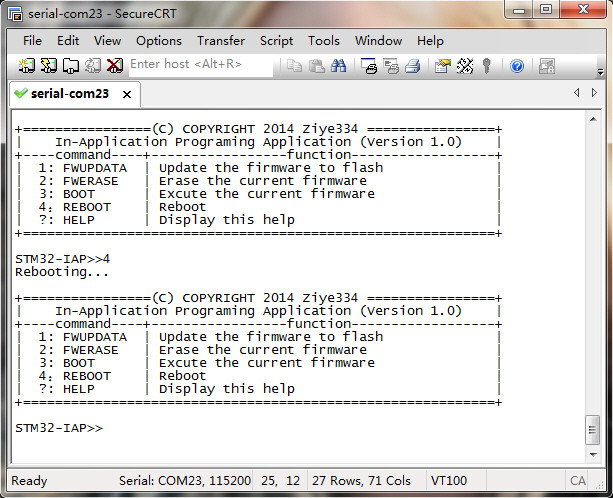
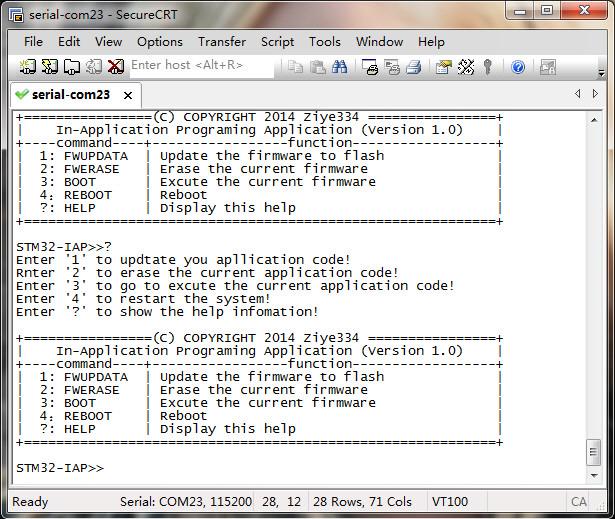
Previous article:Production of STM32 upgrade files
Next article:STM32 Multi-channel Soft Timer
- Popular Resources
- Popular amplifiers
- Naxin Micro and Xinxian jointly launched the NS800RT series of real-time control MCUs
- How to learn embedded systems based on ARM platform
- Summary of jffs2_scan_eraseblock issues
- Application of SPCOMM Control in Serial Communication of Delphi7.0
- Using TComm component to realize serial communication in Delphi environment
- Bar chart code for embedded development practices
- Embedded Development Learning (10)
- Embedded Development Learning (8)
- Embedded Development Learning (6)
 Professor at Beihang University, dedicated to promoting microcontrollers and embedded systems for over 20 years.
Professor at Beihang University, dedicated to promoting microcontrollers and embedded systems for over 20 years.
- Intel promotes AI with multi-dimensional efforts in technology, application, and ecology
- ChinaJoy Qualcomm Snapdragon Theme Pavilion takes you to experience the new changes in digital entertainment in the 5G era
- Infineon's latest generation IGBT technology platform enables precise control of speed and position
- Two test methods for LED lighting life
- Don't Let Lightning Induced Surges Scare You
- Application of brushless motor controller ML4425/4426
- Easy identification of LED power supply quality
- World's first integrated photovoltaic solar system completed in Israel
- Sliding window mean filter for avr microcontroller AD conversion
- What does call mean in the detailed explanation of ABB robot programming instructions?
- 2024 China Automotive Charging and Battery Swapping Ecosystem Conference held in Taiyuan
- State-owned enterprises team up to invest in solid-state battery giant
- The evolution of electronic and electrical architecture is accelerating
- The first! National Automotive Chip Quality Inspection Center established
- BYD releases self-developed automotive chip using 4nm process, with a running score of up to 1.15 million
- GEODNET launches GEO-PULSE, a car GPS navigation device
- Should Chinese car companies develop their own high-computing chips?
- Infineon and Siemens combine embedded automotive software platform with microcontrollers to provide the necessary functions for next-generation SDVs
- Continental launches invisible biometric sensor display to monitor passengers' vital signs
- Another technical solution for power-type plug-in hybrid: A brief discussion on Volvo T8 plug-in hybrid technology
- Virtual Parallel Oscilloscope
- Switching power supply design
- Gallium nitride substrate production technology and equipment
- Vivado generates IP core issues
- Safety temperature standards for main components of switching power supplies
- LabView Notes 1: Three methods based on LabView to implement the water lamp experiment
- Auxiliary trainer for plank and push-up exercises
- MicroPython will add serial port interrupt function
- MOS tube
- C6678 on-chip storage space allocation mechanism

 5962-89621012XA
5962-89621012XA
















 京公网安备 11010802033920号
京公网安备 11010802033920号